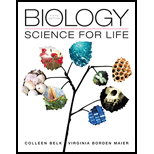
Concept explainers
To describe:
The process of
Introduction:
The speciation is the process, through which the different species have evolved from a single ancestor. The speciation occurs when the organism genetic composition is changed according to the environment, they are living in.
Explanation of Solution
For the process of speciation, there should be a change in the environment of the members of a single species. The main factor, which can be use to detect the occurrence of the speciation involves the reproductive incompatibility from the previous species.
The three steps of speciation are given below:
1. Divergence: in this step, members of a single species are diverged into different groups. Some of the gene pool of the population become isolated from each other.
2. Evolution of new traits: depending on the environment, the separated gene pool evolves certain characters, which make them genetically different from the species they have evolved.
3. Reproductive incompatibility: due to the changes in the genetic composition, the species cannot mate with the members of the species, from which it has evolved.
The three steps of speciation are, divergence of the members, adaptation and evolution according to the new environment and evolution of reproductive incompatibility.
Want to see more full solutions like this?
- Use two different colors to depict the unduplicated chromosomes of species C with larger chromosomes (2n = 8) and species D with slightly smaller chromosomes (2n =10), and of their F1 hybrid. Is the hybrid likely to befertile?arrow_forwardCurly wings is a recessive character in the fruitfly Drosophila melanogaster. The wild type dominant phenotype is straight wings. Flies heterozygous for straight wings were mated and the resulting offspring were a mix of straight and curly winged flies. What is the probability that of the 5 offspring from a single pair mating will be curly winged and 5 were straight winged? Use the binomial expansion.arrow_forwardThere are two different phenotypes of a moth species, black and light grey, which are predated upon by birds. The more recently evolved black colour, is the dominant allele, B, while the recessive allele, b gives a light grey colour. Reduced pollution in the area has turned the trees (where the moths live) lighter. Which moth genotype(s) would be favoured by this change? Select one: O a. DD only O b. Dd only c. dd only O d. DD and Dd O e. DD and dd Of. Dd and ddarrow_forward
- fill the blankarrow_forwardShow an example of Robertsonian Translocation using lettersarrow_forwardCan you answer all the parts to this diagram Species 1 and 2 are sister species from which you’ve cloned related genes. On the gene tree on the top of the next page, use labels to answer the following questions: (a) Label the node that represents a gene duplication with “D,” (b) Label the nodes that represent speciation events with “S,” (c) Pick a pair of genes that are paralogs and label them both “P.” (d) Pick a pair of genes that are orthologs and label them both “O.”arrow_forward
- How would you determine whether the cause of variation is genetic or environmental?arrow_forwardConsider the following statement: ‘female, w+w flies have red eyes’. In this example: Group of answer choices 1) w+w is the genotype, and red eyes is the phenotype 2) female is the genotype, and red eyes is the phenotype 3) not enough information provided to determine genotype or phenotype 4) red eyes is the genotype, and w+w is the phenotypearrow_forwardHow do scientists use mitochondrial DNA to estimate reproductive isolation?arrow_forward
 Biology (MindTap Course List)BiologyISBN:9781337392938Author:Eldra Solomon, Charles Martin, Diana W. Martin, Linda R. BergPublisher:Cengage Learning
Biology (MindTap Course List)BiologyISBN:9781337392938Author:Eldra Solomon, Charles Martin, Diana W. Martin, Linda R. BergPublisher:Cengage Learning

